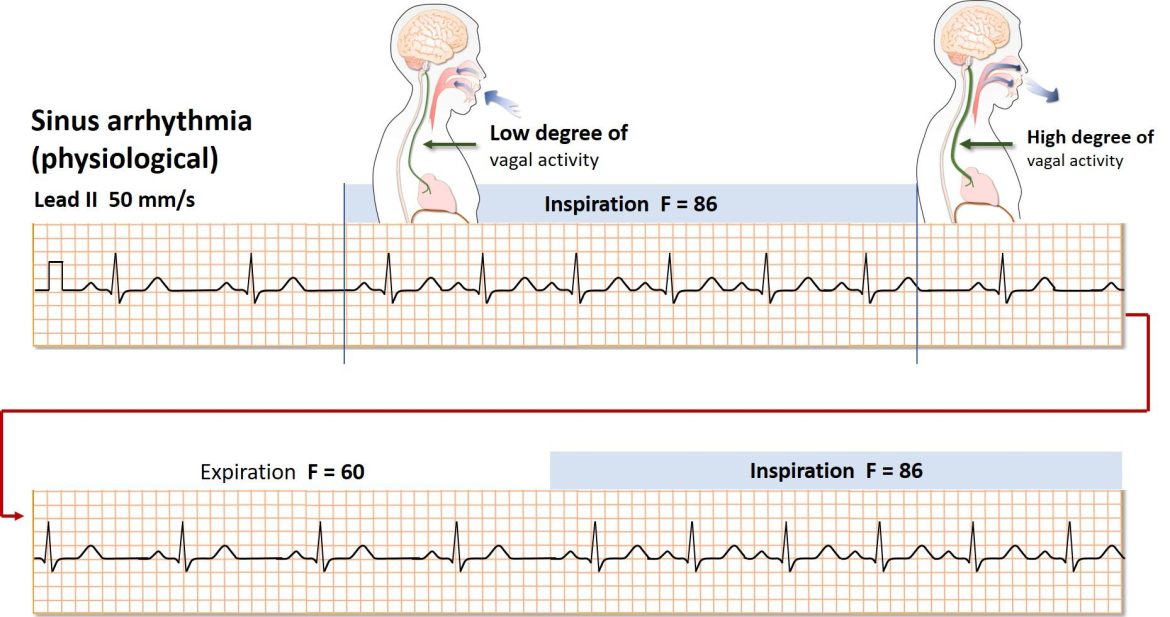Sinus arrhythmia is a naturally occurring variation in heart rate that is often considered benign, especially in younger individuals. Despite its commonality and generally benign nature, understanding sinus arrhythmia’s symptoms, particularly when they become obvious or pronounced, is crucial for both patients and healthcare providers. This article aims to delve into the symptoms of obvious sinus arrhythmia, elucidating its clinical presentation, potential implications, and management strategies.
Understanding Sinus Arrhythmia
Sinus arrhythmia refers to the normal increase and decrease in heart rate that occurs with breathing. It is more prominent in children and young adults and tends to decrease with age. The condition is termed “respiratory sinus arrhythmia” because the heart rate speeds up slightly during inhalation and slows down during exhalation. This phenomenon is due to vagal tone changes in response to breathing cycles.
SEE ALSO: What Foods May Trigger Arrhythmia?
Types of Sinus Arrhythmia
There are two main types of sinus arrhythmia:
Respiratory Sinus Arrhythmia: This is the most common type and is linked to the breathing cycle.
Non-respiratory Sinus Arrhythmia: This type is not related to the breathing cycle and may be associated with other physiological factors or pathological conditions.
Symptoms of Obvious Sinus Arrhythmia
While sinus arrhythmia is typically asymptomatic, some individuals may experience symptoms, particularly when the arrhythmia is pronounced or obvious. These symptoms can vary in severity and frequency. The key symptoms of obvious sinus arrhythmia include:
Palpitations
Palpitations are the most commonly reported symptom of sinus arrhythmia. Patients may describe the sensation of their heart skipping beats, fluttering, or pounding in their chest. These palpitations are usually benign but can cause significant anxiety, especially in those who are not accustomed to them.
Irregular Heartbeat
Patients with obvious sinus arrhythmia may notice an irregular heartbeat. This irregularity is most often perceived during periods of rest or during specific activities that make the irregularity more noticeable, such as lying down or engaging in light physical activity.
Dizziness or Lightheadedness
Some individuals may experience dizziness or lightheadedness, especially if the heart rate variation is significant. This symptom occurs because the irregular heartbeats can momentarily affect blood flow to the brain, leading to transient cerebral hypoperfusion.
Shortness of Breath
Shortness of breath can accompany sinus arrhythmia, particularly if the heart rate changes are pronounced. This symptom may be more noticeable during physical exertion or when lying flat. It is important to differentiate this from other causes of dyspnea, such as heart failure or pulmonary conditions.
Fatigue
Fatigue is a less common but possible symptom of obvious sinus arrhythmia. The irregular heartbeats can affect the efficiency of cardiac output, leading to decreased oxygen delivery to tissues and resulting in a feeling of tiredness or general malaise.
Anxiety
The awareness of an irregular heartbeat can cause significant anxiety in some individuals. This anxiety can exacerbate the perception of symptoms and lead to a cycle of increasing heart rate irregularity and worsening anxiety.
Chest Discomfort
While not common, some patients may experience mild chest discomfort or a feeling of pressure during episodes of pronounced sinus arrhythmia. It is crucial to distinguish this from angina or other forms of chest pain related to cardiac ischemia.
Syncope (Fainting)
In rare cases, pronounced sinus arrhythmia can lead to syncope or fainting, particularly if there is a significant drop in heart rate or a prolonged pause in the heart’s rhythm. This is more likely to occur in individuals with underlying heart conditions or those who are particularly sensitive to changes in heart rate.
Clinical Assessment And Diagnosis
The diagnosis of sinus arrhythmia is typically made through clinical evaluation and electrocardiographic (ECG) monitoring.
Key diagnostic steps include:
Medical History: A thorough medical history to identify any underlying conditions or factors that may contribute to the symptoms.
Physical Examination: A physical examination to assess the heart rate and rhythm, as well as any associated symptoms.
ECG: An ECG is the gold standard for diagnosing sinus arrhythmia. It will show the characteristic variation in the R-R interval that corresponds with the breathing cycle.
Holter Monitor: In some cases, a Holter monitor may be used to record the heart’s rhythm over 24 to 48 hours to capture intermittent symptoms.
Echocardiogram: An echocardiogram may be performed to evaluate the heart’s structure and function, especially if there are concerns about underlying heart disease.
Management of Obvious Sinus Arrhythmia
Management of sinus arrhythmia generally focuses on reassurance and education, as the condition is typically benign.
However, if symptoms are pronounced or bothersome, the following approaches may be considered:
Lifestyle Modifications
Encouraging patients to engage in regular physical activity, maintain a healthy diet, and avoid excessive caffeine and alcohol can help manage symptoms. Stress reduction techniques such as yoga, meditation, and deep breathing exercises can also be beneficial.
Medical Therapy
In most cases, medical therapy is not required for sinus arrhythmia.
However, if symptoms are severe or impact quality of life, beta-blockers or calcium channel blockers may be prescribed to help stabilize the heart rate.
Monitoring and Follow-up
Regular follow-up with a healthcare provider is important to monitor symptoms and ensure there are no underlying conditions contributing to the arrhythmia. Patients should be advised to report any new or worsening symptoms promptly.
Education and Reassurance
Educating patients about the benign nature of sinus arrhythmia and reassuring them that it is a common and usually harmless condition can help alleviate anxiety and improve their quality of life.
Conclusion
Obvious sinus arrhythmia can present with a range of symptoms, from palpitations and dizziness to anxiety and chest discomfort. While the condition is generally benign, it is important for healthcare providers to recognize these symptoms, conduct appropriate diagnostic evaluations, and offer reassurance and management strategies to affected individuals.

